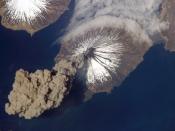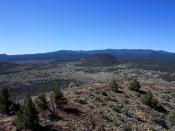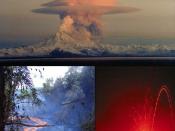VOLCANOES AND MOUNTAINS
Volcanoes are mountains but they are very different from other mountains; they are not formed by folding and crumpling or by uplift and erosion. Instead, volcanoes are built by the accumulation of their own eruptive products lava, bombs (crusted over ash flows, and tephra (airborne ash and dust). A volcano is most commonly a conical hill or mountain built around a vent that connects with reservoirs of molten rock below the surface of the Earth. The term volcano also refers to the opening or vent through which the molten rock and associated gases are expelled.
Driven by buoyancy and gas pressure the molten rock, which is lighter than the surrounding solid rock forces its way upward and may ultimately break though zones of weaknesses in the Earth's crust. If so, an eruption begins, and the molten rock may pour from the vent as non-explosive lava flows, or if may shoot violently into the air as dense clouds of lava fragments.
Larger fragments fall back around the vent, and accumulations of fall-back fragments may move downslope as ash flows under the force of gravity. Some of the finer ejected materiaIs may be carried by the wind only to fall to the ground many miles away.
The finest ash particles may be injected miles into the atmosphere and carried many times around the world by stratospheric winds before settling out. Molten rock below the surface of the Earth that rises in volcanic vents is known as magma, but after it erupts from a volcano it is called lava. Originating many tens of miles beneath the ground, the ascending magma commonly contains some crystals, fragments of surrounding (unmelted) rocks, and dissolved gases, but it is primarily a liquid composed principally of oxygen, silicon, aluminum, iron, magnesium, calcium, sodium, potassium,


